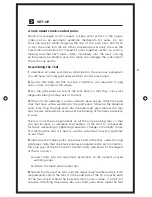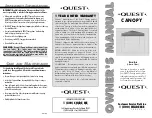
4
its strongest: The wrap-ties allow the poles to reinforce one another in a
series of trusses; they also connect the guyline attachment points directly
to the poles for maximum stiffness when these guylines are rigged.
7
Fit the eight webbing tabs of the fl y on to the ends of all the poles,
placing the grommets over the grommets from the tent body as shown
in fi gures A and B. Fold the grommet tab under the body of the tent,
facing the fi nger pull loop away from the tent to allow for easy removal of
the fl y later.
Alternatively, instead of attaching the four mid-point webbing tabs to
their pole ends, peg them out to the side of the tent using short pieces of
guyline cord; this will provide maximum ventilation and wind stability.
8
Peg out the four vestibule anchor loops at the front and back doors of
the tent fl y; after completing the set-up, you can tighten these anchor
loops for a taut pitch.
Basic Tensioning
Anchor the four corners of the tent to fl atten the fl oor and provide a
stable platform for the poles. The corner loops can accommodate skis
and ice axes as pegs.
Extreme Weather Rigging
The Lightfi eld’s anchor loops and external and internal guy points allow
it to be rigged increasingly securely as conditions worsen, as explained in
the following points roughly according to their order of “need.”
•
If you have not already done so (see Step 6 above), connect the four
Velcro loops inside the fl y to the pole intersections. Peg out the four
grommet web loops at the bases of the short black poles. Guy out the
triangular guy points located midway up the fl y sidewalls.
•
There are four inset blue triangle-shaped guypoints, located on the fl y
over the intersections of the gold and black poles. Guy these out with
the lines at a 45° angle to the door axis.
•
There are four internal guy loops on the top of the inside of the tent and
six on the fl oor. Attach lines connecting the top of one side of the tent
to the bottom of the other side to improve stability and support the
frame. Combine these with the external guy lines if the terrain prevents
the use of external guy points.
fi gure A
fi gure B
Lightfield eng.indd 4
Lightfield eng.indd 4
3/1/05 2:32:25 PM
3/1/05 2:32:25 PM


























